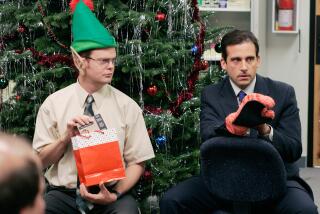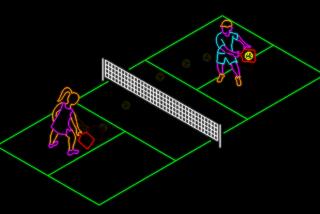Workers’ Romp : Playing War in the Woods Paints Morale a New Shade
- Share via
AZUSA — Rod Corder, a weekend general, has a momentary vision of glory. He sends his decoy troops to the left and takes two other soldiers into the brush on the right.
“They’re up ahead in the bush,” he whispers. Then he creeps forward, engages the pump on his rifle and opens fire. But the enemy isn’t fooled. The canyon is filled with the sounds of “bullets” whistling through the bushes.
Moments later, purple paint drips from Corder’s camouflage outfit. The opposing team had the drop on him.
“I’m hit,” says Corder, co-founder and vice president of engineering at Irvine-based New Media Corp., a 3-year-old company that makes components for laptop computers.
“Dead man!” shouts Jade Marsh, the referee. “Let ‘em out!”
Corder walks away with his air-powered assault weapon above his head and joins other “dead zone” colleagues--heroes awaiting the reincarnation that comes with the beginning of the next round. With mineral waters and sodas in hand, they talk about their battlefield exploits. War is hell. Messy, too.
This popular sport, an exhilarating and exhausting grown-up version of Capture the Flag played with water-soluble colors that quickly evaporate, is known as paint ball. New Media’s owners organize a game a few times a year to build company morale.
Using recreation to improve employee morale is nothing new. Companies such as IBM and AT&T;, for instance, have “assessment centers” where they put their managers through rigorous psychological exercises and games as tests of character.
“The underlying philosophy is to (improve) performance by getting employees more comfortable with each other and working in groups,” said Chris Earley, professor of management at UC Irvine. “People argue about the best way to do that.”
*
Aggressive games like paint ball, however, aren’t ideal for every company, Earley warns. “Paint ball is one way of looking at how employees react to stress, but I would be careful about applying the lessons to the workplace,” he said. “Some people react to it because it is politically incorrect and war-like. Tempers can flare. I wouldn’t say it glorifies war. But some people would.”
Team activities to build morale range from more relaxing events such as bowling teams and golf tournaments to weeks-long backpacking excursions sponsored by groups such as Pacific Crest Outward Bound School in Portland, Ore., in which participants learn how to survive in the wilderness together.
Jaryl Courtemanche, an organizational consultant in Denver, said that ropes-training courses are particularly useful in building interdependence among co-workers’ teams without unnecessarily pitting people against each other.
In such courses, including those offered by The Venture Center in Boulder, Colo., teams of employees have to learn to trust and depend on each other while using ropes to cross streams and scale heights.
But New Media Corp., which expects sales of $54 million this year, has made paint ball its game of choice for enhancing morale because it fits the young company’s aggressive corporate culture, it’s a relatively inexpensive weekend outing and--perhaps most important--the top executives think it’s fun.
“What’s really important is getting the different functions of the company to work together,” said Carl Perkins, president and co-founder. “Too often the people in engineering and sales and marketing don’t mix socially. Here, they can respect each other.”
Eric McAfee, chief financial officer and another co-founder, said the company asks a lot of its employees, so it’s important to let them relax, too.
“These people have to deal with each other day after day. It’s important that they have fun,” he said.
For similar reasons, numerous companies make their way to the California Paint Ball Ranch, which owner Ray Covell opened last year in the foothills of San Gabriel Canyon near Azusa. For individuals, he charges $40 for field, gun and mask rentals--groups receive discounts. On the side, he raises Clydesdale show horses. The ranch is one of a dozen in Southern California.
Randy Kamiya, editor of Action Pursuit Games magazine in Burbank, said that the 13-year-old sport is growing, though not as fast as during its heyday in the mid-1980s. The magazine has an international circulation of 80,000 and is one of about two dozen journals that cover the sport.
“Businesses like the sport because you get to see a genuine reaction of how employees behave under stress,” Kamiya said. “You can determine if somebody’s a leader or a follower.”
Keith Wilcox, a vice president and industrial psychologist with Personnel Decisions Inc., a consulting firm in Minneapolis, said he believes that paint ball is a useful team-building tool, but it has its limits.
In a two-day event that cost about $12,000, his counseling firm will get a company’s work group to defend itself against an attack from paint ball experts and then debrief the workers later about how they can apply the lessons at work.
The events are usually geared toward executives or sales staffs. Because paint ball is competitive, Wilcox said he usually tries to combine it with a cooperative event in which employees are urged to help each other.
“It can be a good thing to awaken the warrior within the employee to get them to focus on the external competition,” he said. “Too often we have to go into companies losing market share and losing sight of the issues.
“We’re careful with it because we don’t want to trivialize war for people who have been in it and we don’t want to romanticize it for those who haven’t been in it. We don’t pit one set of employees against another. Unless you debrief people, it’s just fun and games.”
There is so much interest from businesses that paint ball ranches in Arizona and Minnesota cater mostly to corporate clientele. Last year, Kamiya said he played at the private suburban paint ball ranch of Tom Pritzker, an heir in the wealthy Chicago family that owns a controlling stake in the Hyatt Hotel chain, with a number of high-tech executives.
Covell said he gets all kinds at the ranch. Groups as varied as the Panda Inn restaurant chain, officers from police departments and church groups find reason to fight together. On the day that New Media showed up, a Boy Scout troop dueled at one of the ranch’s 14 battlefields.
“The sport seems to be quite addictive,” he said. “But we’ve had no warmongers. It teaches them teamwork and camaraderie.”
About a quarter of New Media’s employees played during a recent weekend. Perkins enticed one engineer to come by showing him a purchase order for a Pentium personal computer. The lure was simple: If he didn’t play, he wouldn’t get the machine.
New Media’s 32 soldiers--decked in camouflage garb and face masks and armed with air guns that shoot purple or pink paint pellets--started a day of combat with a skirmish in an avocado grove known as the “Jungle.” Perkins’ team squared off against Corder’s band of engineers.
The two sides loaded up on paint pellets, which are like rubbery gum balls, and built up their courage by taking practice shots at some trees. An eerie silence shrouded the field as each group hid among bushes, trees and hills.
Once the whistle blew, the fighting left no room for the timid. As soon as the two sides met in the dense brush, the popping sounds of air guns and splattering paint filled the air. In the distance, real gunfire at the Fish Canyon shooting range in Duarte added realism.
The actual battle quickly dispelled notions of invincibility. Krista McInnis, a new employee at New Media, crept through the Jungle behind Perkins. From nowhere came the sound of a splatter. “Am I dead?” she asked. Purple paint dripped from her goggles. Yes, she was. “Dead Man!” she yelled and walked off the battlefield.
Not every warrior was up to the challenge. Brad Haney, a sales representative, captured the enemy flag and made a dash back to his team’s side. One companion, out of breath, joined him in the race. The pair celebrated victory with high-fives, but the companion soon became ill and threw up his breakfast.
For the whole day, the battle raged back and forth in 10 variations on Capture the Flag. Generally, the winner was able to sift meaning from the chaos and outwit the others with a coordinated strategy. The wanna-be Rambos died first and the patient, crafty thinkers most often captured the flags. Stragglers usually got picked off by teams.
Kelly Danielson, an accounts receivable manager, didn’t start out with a killer instinct. She fired a close-range shot at Haney and it bounced off. She screamed, “I’m sorry!” as Haney turned and fired off a half-dozen shots at her. At 280 feet per second, the paint pellets travel much slower than bullets but they can leave a mean bruise at close range.
By the end of the day, though, Danielson wised up. She got the referees to tell her where Haney was hiding so she could try to exact some revenge. She didn’t get it, though.
Another player dressed in light brown Desert Storm fatigues, Shannon Morrison said she came along with her cousins who work at New Media to get better training to be a police officer. One paint ball left a painful welt on her forehead, but more often than not she left her mark on the enemy. When this recruit for the San Gabriel Police Department switched sides for one battle, the team she was leaving groaned.
The war did have its occasional moments of comic relief. Bryan Siebert, a student who joined the group, made a 100-yard dash to capture the enemy flag in one heated battle where his side was losing. As he ran to victory, his pants were falling down.
The fighting brought out the beasts in some, teamwork in others, as well as leadership and an appreciation of what real fighting must be like.
“Now I know what Beirut is like,” said Alan Friedl, after fighting in a complex of wooden buildings known as Dodge City. “All week, everybody was thinking about coming here and going after the boss.”
Though the injuries by the end of the day were not life-threatening, they were numerous. Jeff Wheeler had 16 black-and-blue marks on his upper body. Mike Friedl, the company controller and Alan’s brother, had five such marks.
“Sometimes you’re the bug, and sometimes you’re the windshield,” he said. In the last battle of the day, Perkins and another teammate charged through the Dodge City area shooting off their empty guns. The company president was hit about a dozen times by the opposing team. One shot pierced his mask and left him with a bloody lip.
“There was no way I was going to sit on the sidelines just because I had no ammo,” Perkins said. “If we brought the lawyers out here, they’d probably be horrified. But I think everyone is going to be much closer on Monday morning.”
More to Read
Inside the business of entertainment
The Wide Shot brings you news, analysis and insights on everything from streaming wars to production — and what it all means for the future.
You may occasionally receive promotional content from the Los Angeles Times.










